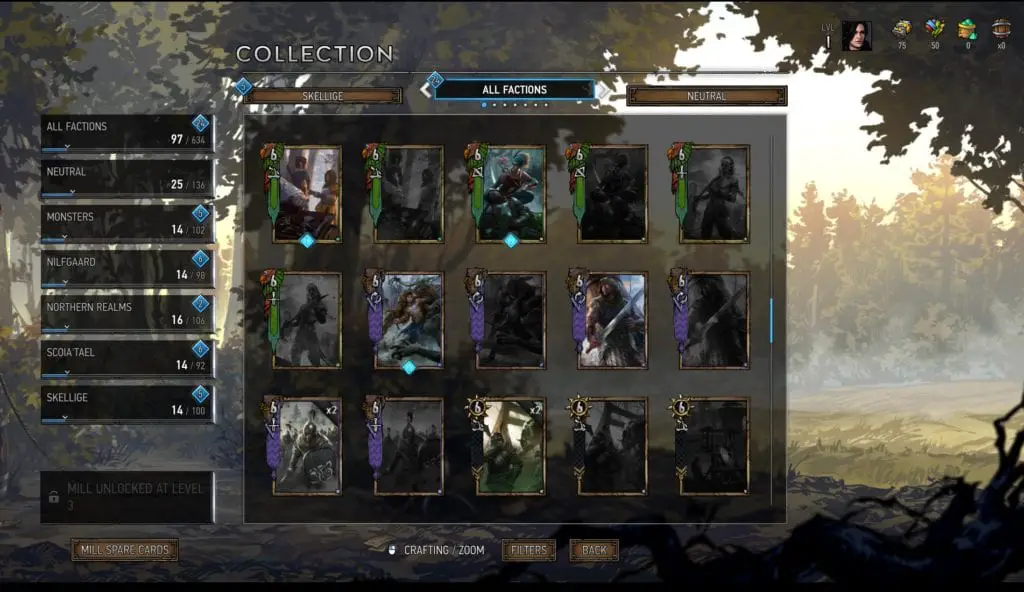Gwent: The Witcher Card Game came out of closed beta on Wednesday. It’s still in beta, mind you. But since now is the time anyone can play it for free, it seemed like a good moment to give it some attention.
Those of you who played Witcher 3 know Gwent as the card game you could have spent game hours on, and lost significant amounts of money. Novigrad crowns, but still. Some remember it fondly. To some, it was more of an irritating distraction. That tantalising exclamation mark you see on the map, that draws you in, only to find out it’s not a story-rich side quest, but merely a random aristocrat wanting to play Gwent.
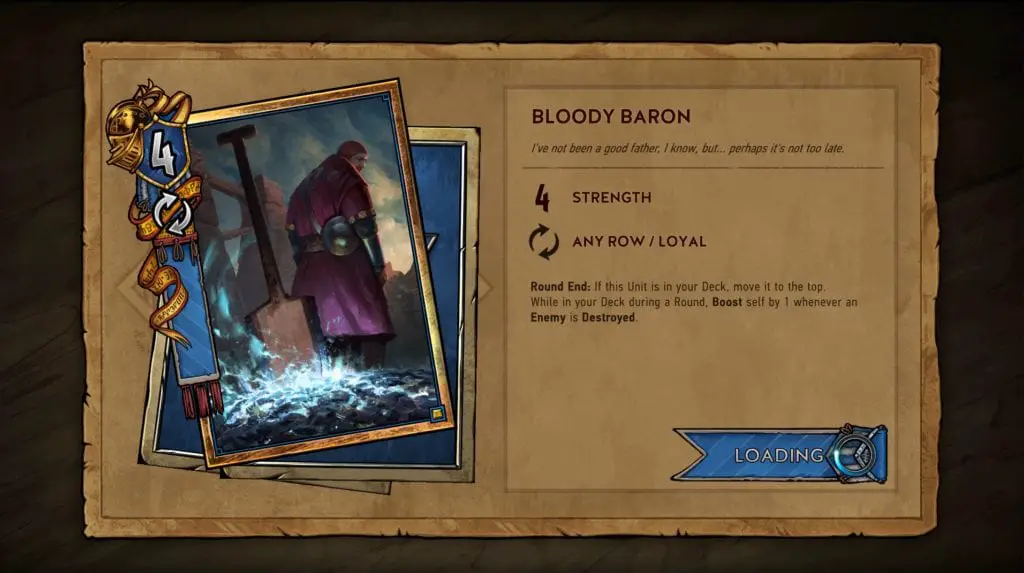
Whichever of those approaches you took, if you expect to find the same game when you open the independent Gwent, you’re going to be disappointed. Or pleasantly surprised, I suppose. Depends how much you liked the old game mechanics.
On your first play, you’re going to be welcomed to an elementary tutorial by Geralt and Ciri. The entire tutorial is framed as Ciri teaching Geralt the rules of this new Gwent. Their banter is very much in character, and a very pleasantly refreshing aspect of going through the boring basics. They, as well as the amazing illustrations on the cards, will keep you interested. The whole game is very pretty, in fact. But then we’d expect nothing else from part of the Witcher franchise. I also very much appreciate relevant quotes from the books and games on every card. Sometimes, they help jostle my memory as to who is who.
Gameplay
Speaking of learning the basics. To give you at least some idea what I’m talking about in case you never played Gwent, let me tell you something about the game mechanics. The general idea behind the game is simulating a battle in the world of the Witcher. You have a deck of twenty-five to forty cards, built out of cards you own. Out of that deck, you draw 10 cards to start with. There are three rows on each side of the battlefield. Melee, ranged, and siege. You play your cards in these rows. Most can only be played on one of them, with some you have a choice. Each card has a strength. The player whose cards have the highest combined strength at the end of a round wins the round.
A round ends when both players pass, or when they are out of cards. You need to win two rounds out of three to win a match. Many of the cards have, apart from their strength, some other special effect. The most common are giving boosts to other cards or doing damage. Then there are special cards, which have no strength of their own and are all about the effects. Again, it’s usually either boost or damage, but stronger one than the “unit” cards have, since they have no other use.
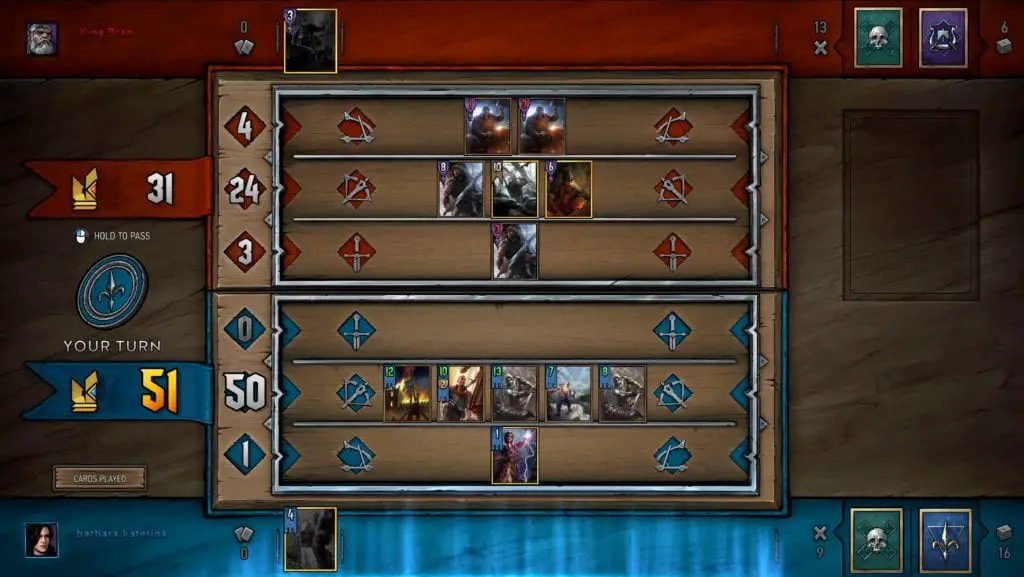
There are different factions you can play for. It’s Nilfgaard, Northern Realms, Skellige, Scoia’tael, and Monsters. Each faction has a specific focus or more, and a particular style of play goes along with it. Monsters, for example, are the ones most made for strong direct attack, and for weather. Nilfgaard has great spying cards, revealing what your opponent holds in hand. Scoia’tael play with tricks and traps. And so on. Then there are some cards that can be included in all decks – almost all special cards, and a few troops, mostly witchers and sorceresses.
Which leads me to what is on the cards. You can encounter specific characters from both the books and the games, like the Bloody Baron card shown above. Or you can use more general ones, like “Redanian elite” or “Blue Stripes”. There is no essential difference between heroes and regular troops, except that the strongest cards are always heroes. They are also “gold” – granting them immunity from most other cards’ effects, positive or negative. There are also silver and bronze cards, more common.
If you click on the above image to enlarge it, you’ll see two “Blue Stripes” on my side of the battlefield, an example of regular units. Incidentally, all the other cards on the same row are also units. A row behind them is Filippa Eilhart, however, and you can see the golden border of her card. Don’t worry about her “1” strength. She has some pretty sweet abilities. The other side has golden Geralt and Ermion, and a bunch of weak units. They’re this weak only since their encounter with Filippa.
The last important kind of cards are leaders. They can be played just like any other card, but usually have some pretty strong ability. It’s always some king that serves as a leader. In this match, I was playing for Foltest, and my opponent was King Bran.
Step-by-step
The tutorial with Geralt and Ciri is part of a section called “challenges”. It contains a few other tutorials and then sort of training matches. You get rewards for getting through all of these.
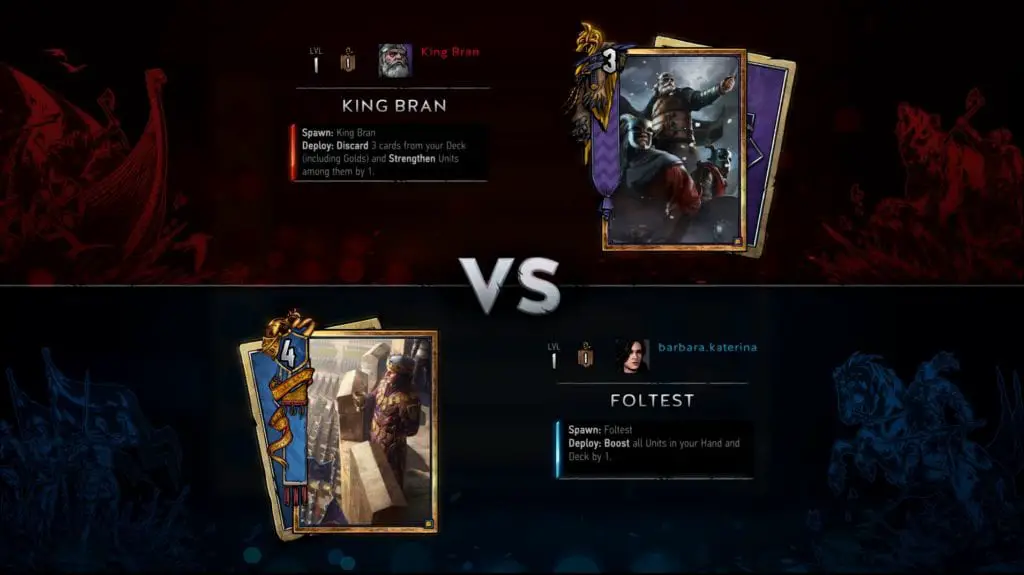
The basic tutorial was pretty fun. It could have been just a tad more comprehensive in my opinion, but I suppose no one likes to spend too much on the basics. The one about deck building is a little more disappointing, however. The absence of Geralt and Ciri is of course a pity. But more than that, it feels that the tutorial covers mostly things anyone who’s ever seen a computer before could figure out on their own, while the more obscure aspects remain unexplained. I understand, of course, that some things can only be found out by practice, but still.
To give an example, the tutorial warns you that you can only have three of each card, or one if the card is silver or gold. That’s nice, but the game doesn’t actually let you craft any more of those cards. It’s not exactly necessary to include the warning. On the other hand, there are cards that have different versions. There the game actually allows you to craft three or one copy, respectively, of each of those versions. Yet you can only have thee or one, total, in your deck. This is something that would be handy to have mentioned in one of the tutorials on deck building, yet there’s not a word to be found. I wasted a good amount of “scraps”, the material you need for crafting new cards, before I figured that one out.
There are six training matches available for each faction – that is, you play six against Nilfgaard, six against Scoia’tael and so on. Each of these has two non-basic leaders there, and each of the leaders has three training matches connected to them. For the first two, you get rewards in iron ore, for the last one, you get that leader’s card. Each match shows you a different strategy that can be sensibly played with the given faction and given leader. It has the double effect of training you to fight against those strategies, and teaching you the strategies in case you want to use them.
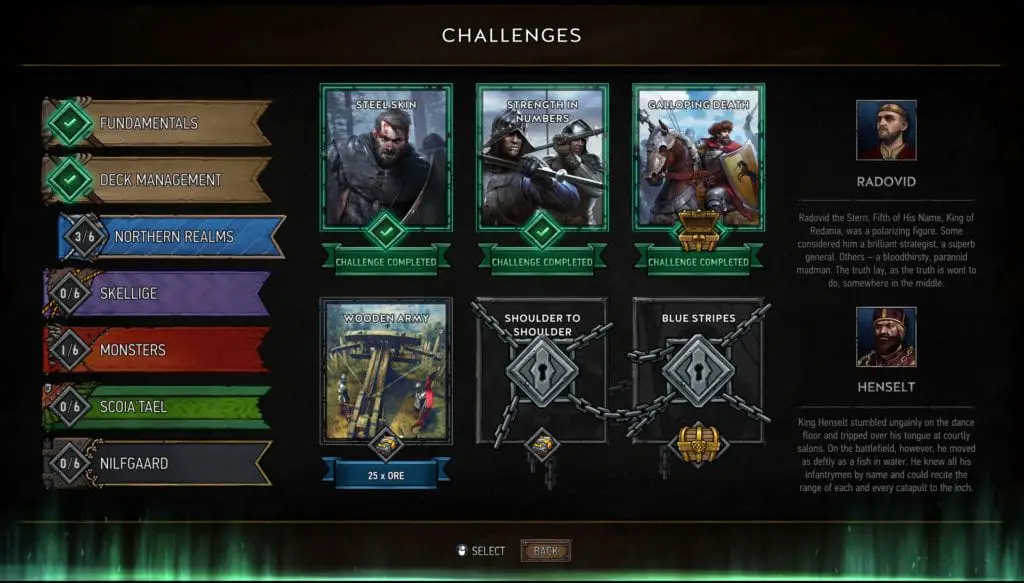
It is a great expansion. It’s perhaps a pity the tutorial aspect wasn’t integrated a bit more into these. I think a more detailed explanation of the particular abilities wouldn’t come amiss. As it is, you’re left to figure out what is the strategy you’re playing against as you go, which can be a little confusing.
Sections
The challenges sit in the single player section of the game, along with training games against AI. As in every game, it’s much easier than against people. There is also the “cards” section where you can edit your decks and your whole card collection. You can mill spare cards for scraps and use those scraps to craft new cards that you want. Scraps can onlo be got as rewards for one matches.
A novelty in the last patch is meteorite dust, which you can use to transmute cards to their animated versions. Another added thing is the “trinkets” subsection, which allows you to change some aspect of your personal profile, like your avatar. Finally, I could change Geralt’s grumpy face to Yenn! The selection is no exactly huge, though. But I suppose this is the sort of thing that is likely to be expanded int he final version of the game.
Another section is the shop, where you can buy card kegs and meteorite dust. Card kegs are purchased either for iron ore, a game currency you get for winning matches, or for regular money. However, meteorite powder can only be purchased for actual, real-world currency. When you buy kegs, you get to interact with a lovely troll who sells them. I have to admit that while I loved them in Witcher, in Gwent, it becomes a little repetitive and tiring after a while.
Each kegs contains five cards, four common ones and then a choice of three of some degree of rarity. You have to pick one you get to keep. The degree of rarity of all three is always the same, but it’s different every time you open a keg, with the least rare being the most common, obviously. As a result, once upon a time, you get three gems impossible to decide between. Most of the time, however – after the initial stage of deck-building – you get three that are only useful for making scraps out of them. Oh well. Better than nothing.
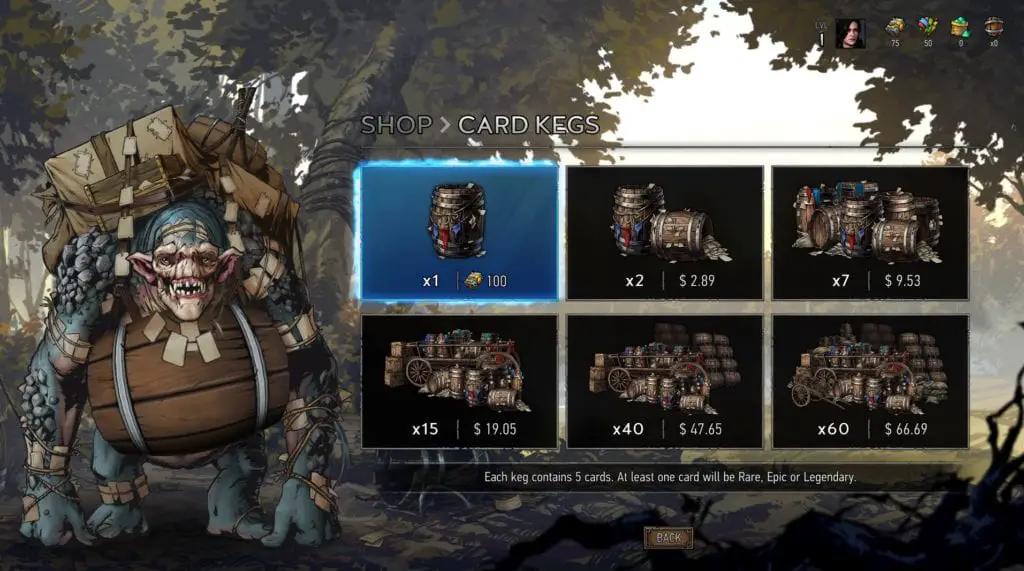
The “options” contains the expected game settings. It also now allows you to explore various game ranks and rewards tied to them, to motivate you to play more. Consider, if only you win sixty-six rounds per day, you’re going to have so much!
The last section is the one with multiplayer, AKA the most important ones. You can play casual matches, matches with friends, and ranked matches that get you position on the leader board. All of this gets you iron ore rewards and advances you in levels, though, and there are rewards for levels as well. So if you don’t feel like trying ranked, don’t worry.
What else is new
I never really played Gwent during Witcher 3. I was one of those who were bothered by Gwent-related exclamation marks. So I’m not exactly qualified to talk about changes compared to that. They’re too numerous to name them all anyway. Instead, let me talk about what updates were made compared to the previous versions of standalone Gwent. One little tweak is that the cards have a new way to explain their abilities, with code-words instead of symbols. It’s much more practical, especially as there are handy vocabularies of relevant codewords provided.
Lots of cards properties changed in the course of the closed beta – most of them, in fact. One novelty at this point is the existence of armour, out of which damage is taken before it hurts the actual strength of troops. Not all units have it, but it can be granted by some special cards. Another interesting new game mechanic is “brave”, which produces effects – usually boosts a unit – when its side is losing the round.
One more change is worth a mention. Different rows became less important, because many more cards now have the ability to be played on any row. That has to do with a new frequent ability: influencing adjacent cards. When a unit boosts in this way, it’s very practical to be able to put it anywhere. However, it’s part of a certain tendency to lessen the realism, as stupid as that sounds said about a card game.
But however you want to phrase it, measures were taken to improve game balance at the expense of faithfulness to the books and games. It’s probably sensible, but as a book snob, I can’t help but grumble. Why are Vilgefortz and Bonhart part of the Nilfgaard faction? Why is Dandelion’s strength eight, while Ioreth and Vernon Roche both have six? What is the cavalry doing on the siege row?
What you won’t see anymore
I played Gwent for a significant part of the time it was in closed beta, and there are some features that I will sorely miss with the new patch that brought the game out in the open. Some of those changes are not so recent, and were introduced earlier this year. Consider this their obituary.
Generally, there was a tendency to turn the game to greater predictability and the give the cards more versatility. That means the most major changes affected chiefly the cards that wreaked true havoc on the battlefield, or could only be used in very specific situations. The most significant of these are weather cards, which originally affected one row on both sides and reduced the value of all cards (except the gold ones and the ones with weather immunity) to one.
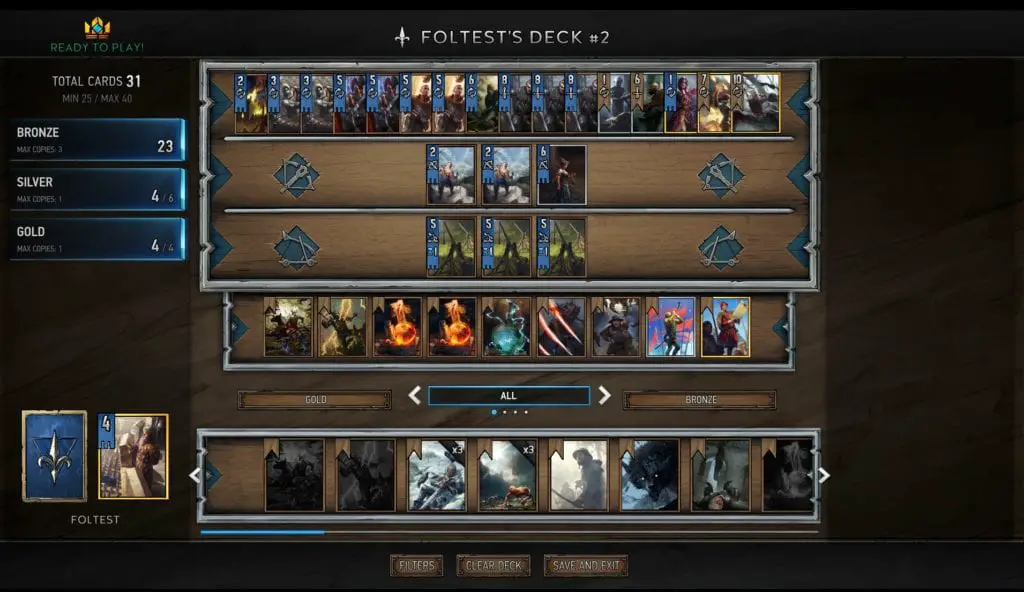
That meant that if you wanted to play weather, your entire deck had to be be built around it. You needed gold cards and weather resistant cards, or weather that affected rows on which you had little to no cards. There was “clear skies”, the card that took the weather effects away, but since it was completely useless unless a weather effect was in play, no one wanted to put in into their deck too many times. It meant sacrificing general use cards for something pretty particular. But then if you didn’t put it in and went against a weather-based deck, well, you were pretty much licked.
This started to change in stages. Clear skies became one of two alternate effects of a “first light”, the other one being playing a card from the discard pile. Suddenly it was less of a loss to put it in. Later, weather was significantly strengthened to only affect one side of the battlefield. Suddenly, all the strategy connected to putting weather cards in your deck went out of the window. And now, the weather cards don’t set the value of the affected cards to one. They just make it a little lower.
It still sometimes affects an entire row, so it is significant, but nowhere near as major a thing as it used to be. You can ignore weather much more comfortably now. Along with this change, many cards lost their weather immunity, so it would be more difficult to build a weather-resistant deck. But, well, no one really needs to anymore, and a few other cards gained the “clear sky” effect, so all in all the difference is not so great.
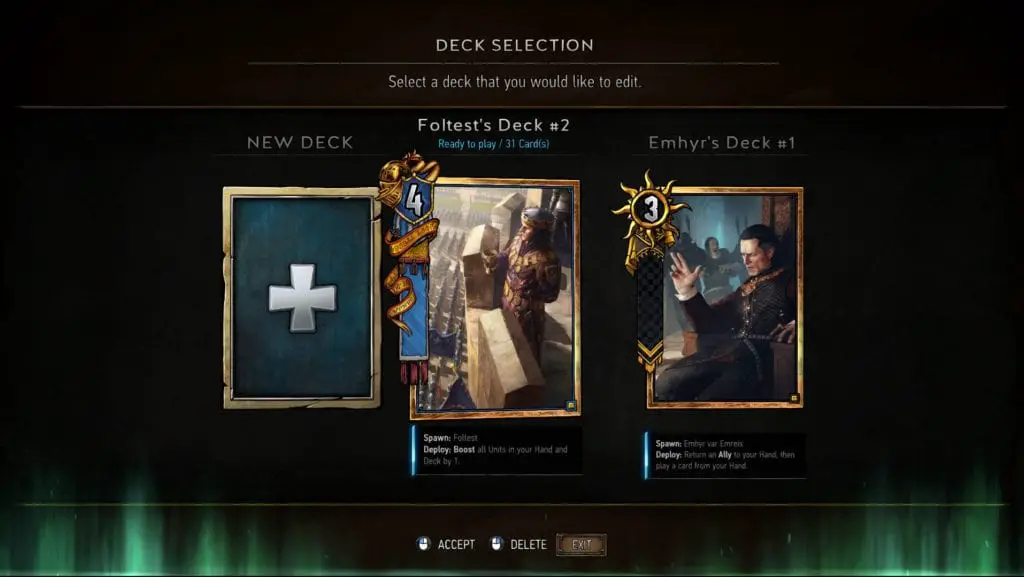
A similar story concerns commander’s horn, an extremely powerful card that originally doubled the strength of an entire row. I’m sure you can imagine it was a very significant game-changer. First it was nerfed to only give a boost to the row, and now it only affects five cards in a row, giving them a significant boost. So some of the most popular strategies connected to it were weakened. When you have one very powerful card on the row, it doesn’t help much. The Horn is still a pretty useful card, but much like with weather, it’s no longer a complete game-changer.
Quite a number of other cards was weakened as well, apparently to limit the effect of luck when one gets just the right cards in their hand. On the other hand, the tendency to make cards more versatile and universally usable, which already showed with “clear sky”, manifests itself with other cards too.
The witcher potions losing their special boost bonus when used on witcher cards is perhaps understandable, since there were only three cards it could apply to in the entire game. I’m just miffed because I took generous use of it. However, thunderbolt potion, which used to give boost to all copies of the same card, now gives a boost to a set number of cards regardless of their type.. So, once again, more universal. Other cards that were useful only with specific abilities got additional bonuses, like decoy, mitigating the risk involved in including them in the deck and then getting them without the cards they went with. Again, much like “clear skies”.
I can’t help feeling, however, that less surprises will make the game much less interesting. Suddenly losing everything because of a few cleverly played weather cards was frustrating, sure. But in turn, it gave you a change to laugh at your opponent wasting all of their good cards as they tried to trump your commander’s horn…
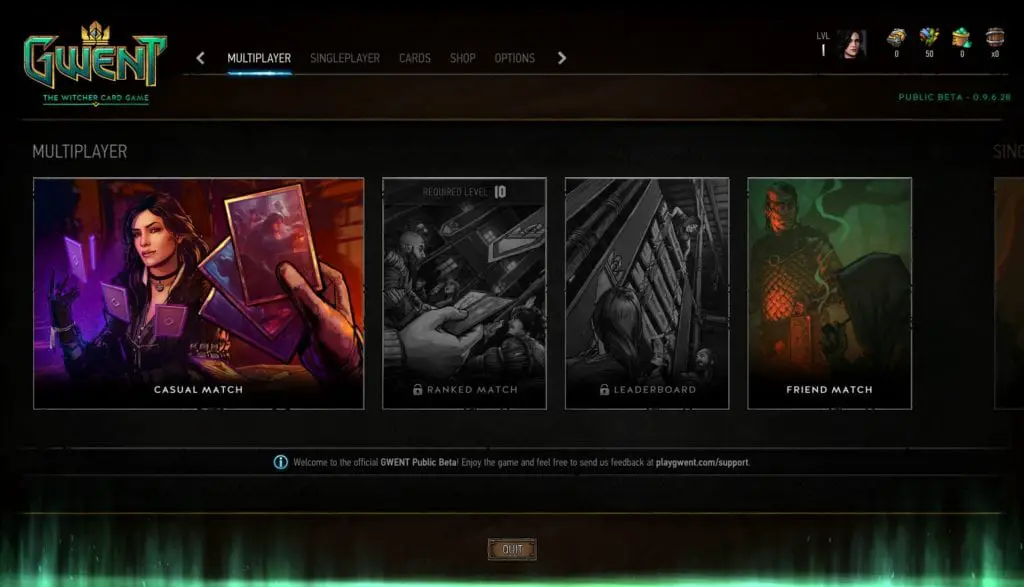
Oh, and one more thing I shall dearly miss: faction abilities. They’re gone. Of course, the factions still have different types of cards and so different focuses (foci?), but I regret any loss of individuality of the factions, any loss of variation. Plus some of those abilities were legitimately cool.
If you’ve played already in closed beta, you’ll lose your cards and your deck and your level. In short, everything. It’s understandable they don’t want new players to be overwhelmed by old experts with much better decks, but still, it was a nasty shock when I opened my card collection to see all of my prized possessions gone. But well. Half of them had changed abilities anyway, so I suppose it doesn’t matter quite so much.
There used to be a locked icon for “campaign” in single-player section. That is now gone, replaced with challenges. However, the campaigns are definitely in the works. Probably something that’s being kept for the alpha version. It’s rumoured to retell some of the book events that are battle focused, so that could be fun.
I was disappointed with some of the changes made to Gwent, chiefly those that put the game farther away from the Witcher universe and those that made it more predictable. But it’s still a great, enjoyable game with fantastic illustrations. It’s a pleasant way to stay connected to a universe many of us dearly love. And with the campaigns to drop one day, we might never actually leave…


